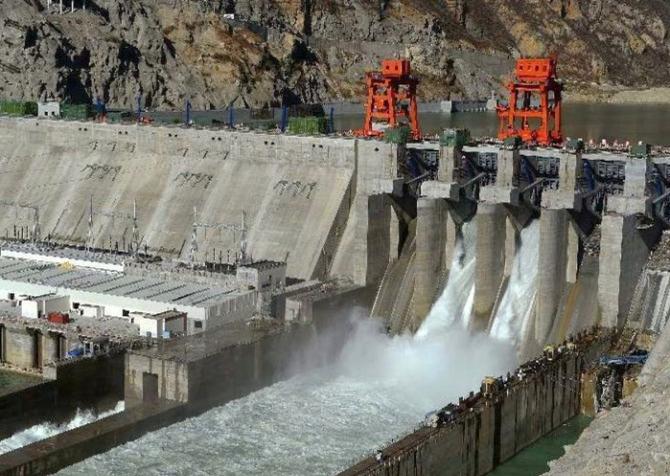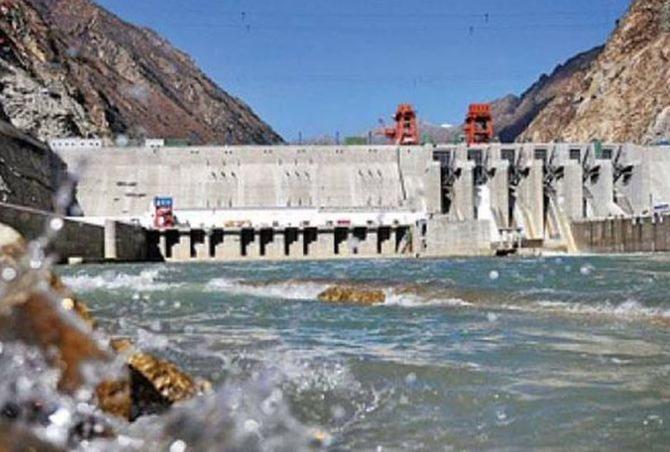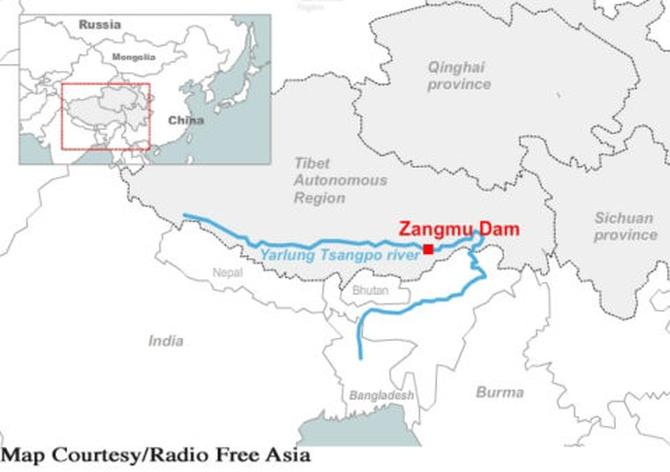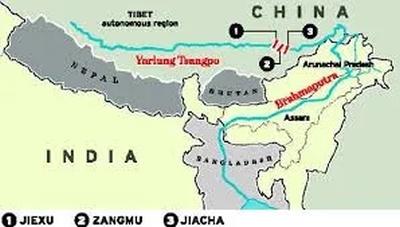 | « Back to article | Print this article |
'India is planning to construct a multipurpose reservoir.'
'It will be a 10,000 MW hydropower project to offset the impact of the hydropower project by China.'

For the Chinese, water is a key weapon in their expansionist designs.
It is not therefore not surprising that although India is already facing Chinese territorial aggression in Ladakh, our powerful eastern neighbour is busy finalising plans to construct a large dam on the Brahmaputra which originates from Tibet where it is known as Yarlung Tsangbo.
The Chinese are already building several dams on the Brahmaputra and its tributaries.
Three of these dams -- namely the Jiexu, Zangmu and Jaicha -- are within 25 km of each other and are just 550 km from the Indian border.
A week ago, the Power Construction Corporation of China dropped a bombshell by stating that it had been given the green signal to construct a dam with a hydropower capacity of 60 GW on the Brahmaputra.
This has created fresh apprehension in the Indian government who realise they have no alternative but to come up with a strong viable alternative.
T S Mehra, Commissioner, Brahmaputra and Barak in the north east for the Union ministry of water resources, believes India can no longer sit back and watch this dam-building spree by China, but rather, we need to come up with a comprehensive water management plan for the north-east to counter this offensive.
Speaking exclusively to Rashme Sehgal for Rediff.com, Commissioner Mehra outlines immediate steps that India had on the cards.
How does India plan to counter this move to construct dams on China? Where exactly is China planning to construct the dam on the Brahmaputra?
As a first step, India is planning to construct a multipurpose reservoir. It will be a 10,000 MW hydropower project to offset the impact of the hydropower project by China.
The Brahmaputra is called Siang in Arunachal Pradesh and this 9.2 BCM will be able to take the excess load of water discharge and store water during the lean months.

When is work on this project likely to start?
Every project takes a long time to finalise. For the present, it is at a preliminary stage of consideration.
Our project is awaiting clearance from the highest echelons of the government.
Can you provide some details of the Chinese power project and what its impact is going to be on the lower riparian states including Bangladesh?
The details have not been disclosed as of yet. All we have is the statement by the Chinese.
We understand it will be in the upper reaches of the Siang, but until we get a chance to study their detailed project report, we do not know its details.
All we know is that they are planning a big project on the Brahmaputra river.
The Brahmaputra is a very swift-flowing river especially when it flows through the Tibetan plateau.
The Chinese can execute big projects. They have mastered it. Look at the Three Gorges project built on the Yangtze river. It is the largest dam structure in the world.
What are the details you have managed to gather about the dam being built?
We have had no meeting with our Chinese counterparts on this subject so far. As far as I understand, nothing has been finalised on this project so far.
There is a statement on this by the Chinese embassy. It is still at a study stage.

India has in the past expressed concern that if the waters are diverted due to all this dam building, then projects on the Brahmaputra, particularly the Upper Siang and Lower Suhansri projects in Arunachal Pradesh, may get affected?
As I said ,it is too early to make any comments.
Yes, but what do you feel?
Every project has its positive and negative impact, which we can only know once the details of the detailed project report are made available.
The positive aspect is that its construction leads to the economic development of the area where it is built.
Taking a long term perspective, I would like to point out that China could plan to take water from Tibet to Xinjiang which is a water deficit area.
Technically, this can be done. I do not foresee any problems in taking water apart from the expense involved in executing such a project.
But will construction of these dams affect the flow of water in the Brahmaputra?
Water flows do change. Ninety per cent of the Brahmaputra's water comes through its tributaries in India during the monsoon season thanks to the abundant rainfall in the north east region.
It is only the winters that 80 per cent of the Siang river gets its water from the upper stretches as glaciers which become the main source.
Additional water is released during floods and there is a decrease of water in the lean season. But all this will depend on how the Chinese visualise the project.
As I have already said, I can speak with greater clarity once I have more details.
Can you provide some details of what India is visualising in Arunachal?
It's going to be a big project. We need to create storage to store water in the monsoon moon.
We also need to build capacity to manage floodwaters and for this, we must have the capacity to absorb an extra flow of water.
But we are not going to be executing this project. This will be built by the ministry of power because it is being built to enhance our power generating capacity. It is they who will prepare the detailed project report for this.

A number of dam projects are already being executed in the north east?
No, only two to three dams are being constructed. Earlier, private players were to execute these projects, but they could not proceed ahead.
These private players did not find these projects economically viable.
What then is the role of the ministry of water resources in the construction of the new dam?
We are there to provide supplementary information such as providing their techno-economical viability.
We are there to ensure that all the water resources criterion and the guidelines are being met.
Our job in the Central Water Commission is to provide all the technical supervision.
Is what the Chinese dam going to be a run-of-the-river project?
We are waiting to get all the details.

There is also the issue of China not being forthright in giving flood-related data to India?
China has been giving flood-related information for the last two years. There was a problem in 2017.
Previous flood-related data was not given because the flood sites were washed out and so this data could not be passed on.
For Brahmaputra, flood-related information is given from between May 15 to October 15 and for the Sutlej, data is given from June 1 to October 15.
Flood information areas that are provided are being utilised by CWC for flood forecasting.
I must point out to you that China is also providing information on blockages and landslides. This information is also provided beyond the MoU period.
The CWC is also providing information directly. India has a field office looking at the flood control situation located at Dibrugarh which also provides information.
Is this information also being given to Bangladesh?
Bangladesh is given information directly from China.
We are now a lower riparian country vis a vis the Brahmaputra. China does not have the best reputation on how they have shared the waters of the Mekong river with the lower riparian countries?
China claims they are cooperating very well on the Mekong river. If there is a problem, I am not aware of it.
Feature Presentation: Rajesh Alva/Rediff.com